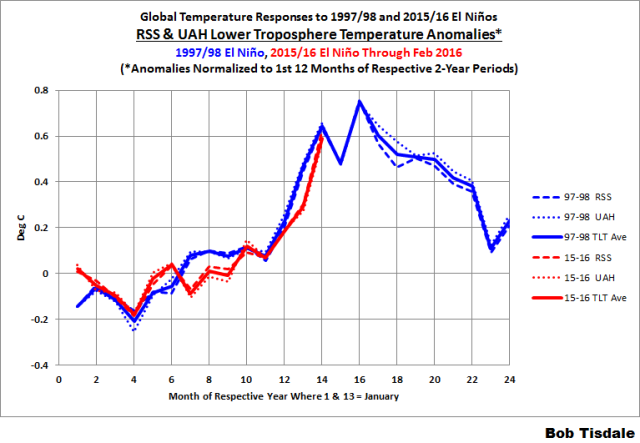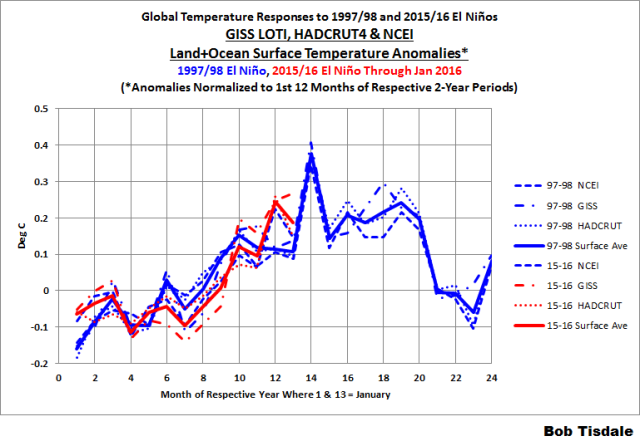In lagged responses to the 2015-16 El Niño, there have recently been sizable upticks in the lower troposphere temperature data from both RSS and UAH, as shown in Figure 1.
Figure 1
The following is a quick update on the global temperature responses to the strong 1997/98 and 2015/16 El Niño events. It’s in a slightly different format than the update in January. If global temperatures respond to the 2015/16 El Niño as they had for the 1997/98 El Niño, we should expect to see a couple of additional upticks this year in lower troposphere and surface temperature anomalies.
PRELIMINARY NOTES
The illustrated temperature anomalies are as provided by the suppliers, but for comparison purposes, I’ve shifted them, normalizing them to the average of the first 12 months of the respective 2-year periods. In the following graphs, I’ve included the data from the individual suppliers and their averages. The lower troposphere temperature data run through February 2016 and the surface temperature data run through January 2016.
LOWER TROPOSPHERE TEMPERATURE ANOMALIES
Data Sources: RSS here and UAH (version 6.0, beta 5) here. (RSS so far has not updated their lower troposphere data to version 4.)
As shown in Figure 2, the responses of the lower troposphere temperature data to the 2015/2016 El Niño are similar to the responses to the 1997/98 event.
Figure 2
LAND + OCEAN SURFACE TEMPERATURE ANOMALIES
Data Sources: NASA/GISS LOTI here, NOAA/NCEI here, and UKMO HADCRUT4 here.
Due to the differences in the three surface temperature datasets, there’s a lot of visual noise in the comparison shown in Figure 3. But if we concentrate on the bold, solid average curves, the responses of the surface temperature data to the 2015/2016 El Niño are similar to the responses to the 1997/98 event. Also see the discussion of uncertainties later in the post.
Figure 3
With a maximum of 2 years of data and with the data normalized, we would not expect to see the impacts of the “Karlization” of the NOAA ERSST.v4 “pause-buster” sea surface temperature data.
COMPARISON OF LOWER TROPOSPHERE AND SURFACE TEMPERATURE AVERAGES
You’ll note the scale of the y-axis in Figures 2 and 3 are different. Figure 4 includes the averages of the lower troposphere and surface temperature datasets, to put them in perspective.
Figure 4
THE LOWER TROPOSPHERE SHOWS A GREATER RESPONSE THAN THE SURFACE TO THE EL NIÑOS
In response to an El Niño, only a portion of the temporary upticks in global surface temperatures are a direct result of the warming of the eastern tropical Pacific (caused by the warm subsurface waters of the western tropical Pacific being shifted to the surface of the eastern tropical Pacific). Elsewhere around the globe, due to changes in atmospheric circulation caused by the El Niño, Earth’s surfaces warm and cool relative to their “normal” seasonal conditions, but more of the global surfaces warm than cool, so global surface temperatures rise. There are also long-lasting responses to strong El Niños (Trenberth “big jumps”), when the leftover warm waters from the El Niño are redistributed around the surfaces of the global oceans.
On the other hand, the rises in lower troposphere temperatures in response to an El Niño are caused in two ways: first, by the increases in surface temperatures in the tropical Pacific and around the globe. Second, an El Niño releases a monumental amount of heat from the tropical Pacific to the atmosphere, primarily through evaporation. That additional warm and moist air rises into the colder atmosphere, cooling as it rises higher, and when the moisture condenses and form clouds, that heat from the tropical Pacific is released to the atmosphere…thus the additional warming of the lower troposphere.
THE UNCERTAINTIES OF THE DATA
THE UK Met Office is the only global temperature supplier to provide uncertainties on the same webpage as their monthly data (format here). For those interested, Figure 5 includes the evolutions of the HADCRUT4-based global surface temperature anomaly responses to the 1997/98 and 2015/16 El Niños, with the lower and upper bounds (columns 11 and 12) of the 95% confidence intervals of the combined effects of all the measurement and sampling, bias and coverage uncertainties. The top graph is the monthly data, and in the lower graph, I’ve smoothed the data with a 3-month running-mean filter to minimize some of the weather noise.
Figure 5
FOR THOSE NEW TO DISCUSSIONS OF EL NIÑO EVENTS
I discussed in detail the naturally occurring and naturally fueled processes that cause El Niño events (and their long-term aftereffects) in Chapter 3.7 of my recently published free ebook On Global Warming and the Illusion of Control (25 MB). For those wanting even more detail, see my earlier ebook Who Turned on the Heat? – The Unsuspected Global Warming Culprit: El Niño-Southern Oscillation. Who Turned on the Heat? only costs $5.00 (US).
CLOSING
As noted in the opening, if global temperatures respond to the 2015/16 El Niño as they had for the 1997/98 El Niño, we might expect to see a couple of additional upticks this year in the lower troposphere and surface temperature anomalies.
Will the evolutions of global temperatures this year mimic 1998?
One wild card is The Blob, which was the primary cause of the “record” surface temperatures in 2014. (See GENERAL DISCUSSION 2 – On the Claims of Record-High Global Surface Temperatures in 2014 of my ebook On Global Warming and the Illusion of Control.) The Blob continues to dissipate rapidly, but it might reemerge in 2016. See the post here. IF (big if) The Blob continues to dissipate and doesn’t reappear later in the year, and IF (big if) it doesn’t have any long-term effects on the North Pacific, then its disappearance could suppress some of the additional El Niño-related warming in 2016. We just have to grab some popcorn and watch…better stock up, this is gonna take a while.








Thought: If the current blob is the eventual migration of brought-to-the-surface warm water from a previous strong El Nino with a lag of +years, the present strong El Nino might also produce that echo some years away. Might this be the normal fine scale behavior at the peak of an interglacial warm period such as suggested by the 400,000 reconstructed temperature pattern?
I agree. There might be further probably modest increases through April.
See http://wattsupwiththat.com/2016/03/03/after-el-nino-will-the-global-warming-pause-continue/#comment-2158044
my post disappeared
It’s there, Pamela.
Pingback: “Global Warming” Reality Check Februar 2016: Die globale Erwärmungs”pause” seit 1997 setzt sich fort – RSS 0,94 – wobleibtdieglobaleerwaermung
Pingback: February 2016 Global Surface (Land+Ocean) and Lower Troposphere Temperature Anomaly Update | Bob Tisdale – Climate Observations
Pingback: February 2016 Global Surface (Land+Ocean) and Lower Troposphere Temperature Anomaly Update | Watts Up With That?
Pingback: February 2016 Global Temperature Update | The Global Warming Policy Forum (GWPF)
Pingback: Many Scientific “Truths” Are, In Fact, False | Atlas Monitor
Pingback: “Global Warming” Reality Check März 2016: Die globalen Temperaturen gehen wieder zurück – UAH 0,73 – wobleibtdieglobaleerwaermung
Pingback: „Global Warming“ Reality Check April 2016: Die globalen Temperaturen gehen weiter zurück – wobleibtdieglobaleerwaermung
Pingback: Die globale Abkühlung verstärkt sich – „Global Warming“ Reality Check Mai 2016 – wobleibtdieglobaleerwaermung
Pingback: Absturz der globalen Temperaturen! Ungewöhnlich schwache Sonne – La Niña kommt: „Global Warming“ Reality Check Juni 2016 – wobleibtdieglobaleerwaermung
Pingback: Schwache Sonne – kühle Erde! La Niña ist da: „Global Warming“ Reality Check Juli 2016 – wobleibtdieglobaleerwaermung
Pingback: Das Jahr 2016 ist nun kälter als 1998: „Global Warming“ Reality Check August 2016 – wobleibtdieglobaleerwaermung
Pingback: Das Jahr 2016 bleibt kälter als 1998: „Global Warming“ Reality Check September 2016 – wobleibtdieglobaleerwaermung